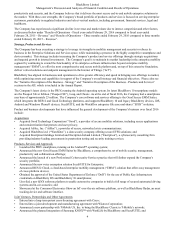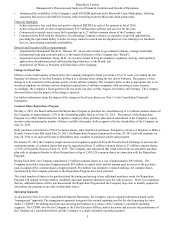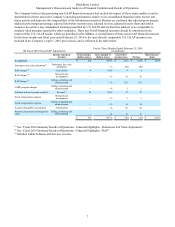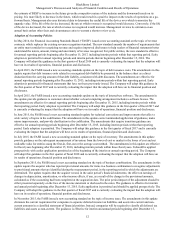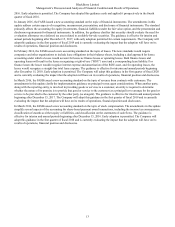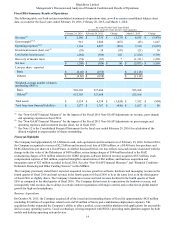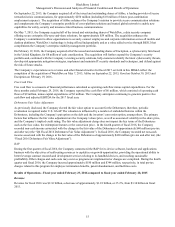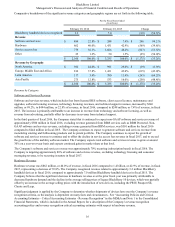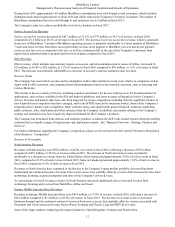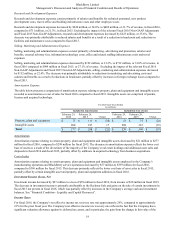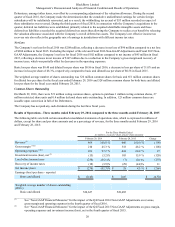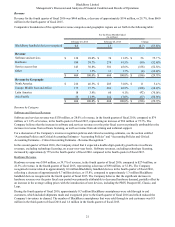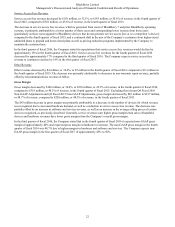Blackberry 2016 Annual Report Download - page 120
Download and view the complete annual report
Please find page 120 of the 2016 Blackberry annual report below. You can navigate through the pages in the report by either clicking on the pages listed below, or by using the keyword search tool below to find specific information within the annual report.BlackBerry Limited
Management’s Discussion and Analysis of Financial Condition and Results of Operations
12
the estimate of BESP to increase in the future given the competitive nature of the industry and the downward trends on its
pricing. It is more likely to decrease in the future, which would result in a positive impact on the results of operations on a go-
forward basis. Management also uses historical data to determine the useful life of the device over which to amortize the
upgrade value. If the life of the device increased, the rate at which revenue is recognized would decrease. Conversely, if the life
of the device decreased, the rate at which revenue is recognized would increase. Management reviews its estimates on an
annual basis unless other facts and circumstances arise to warrant a shorter review cycle.
Adoption of Accounting Policies
In May 2014, the Financial Accounting Standards Board (“FASB”) issued a new accounting standard on the topic of revenue
contracts, which replaces the existing revenue recognition standard. The new standard amends the number of requirements that
an entity must consider in recognizing revenue and requires improved disclosures to help readers of financial statements better
understand the nature, amount, timing and uncertainty of revenue recognized. For public entities, the new standard is effective
for annual reporting periods beginning after December 15, 2017, including interim periods within that reporting period. Early
adoption is permitted for annual reporting periods and interim periods therein beginning after December 15, 2016. The
Company will adopt this guidance in the first quarter of fiscal 2019 and is currently evaluating the impact that the adoption will
have on its results of operations, financial position and disclosures.
In April 2015, the FASB issued a new accounting standards update on the topic of debt issuance costs. The amendments in this
update require that debt issuance costs related to a recognized debt liability be presented in the balance sheet as a direct
deduction from the carrying amount of that debt liability, consistent with debt discounts. The amendments are effective for
annual reporting periods beginning after December 15, 2015, including interim periods within that reporting period. Early
adoption is permitted for financial statements that have not been previously issued. The Company will adopt this guidance in
the first quarter of fiscal 2017 and is currently evaluating the impact that the adoption will have on its financial position and
disclosures.
In April 2015, the FASB issued a new accounting standards update on the topic of internal-use software. The amendments in
this update provide guidance to customers about whether a cloud computing arrangement includes a software license. The
amendments are effective for annual reporting periods beginning after December 15, 2015, including interim periods within
that reporting period. Early adoption is permitted. The Company will adopt this guidance in the first quarter of fiscal 2017 and
is currently evaluating the impact that the adoption will have on its results of operations, financial position and disclosures.
In June 2015, the FASB issued a new accounting standards update for technical corrections and improvements that affect a
wide variety of topics in the codification. The amendments in this update correct unintended application of guidance, make
minor improvements, and provide clarification to the codification. The amendments that require transition guidance are
effective for annual reporting periods beginning after December 15, 2015, including interim periods within that reporting
period. Early adoption is permitted. The Company will adopt this guidance in the first quarter of fiscal 2017 and is currently
evaluating the impact that the adoption will have on its results of operations, financial position and disclosures.
In July 2015, the FASB issued a new accounting standard update on the topic of inventory. The amendments in this update
provide guidance on the subsequent measurement of inventory from the lower of cost or market to the lower of cost and net
realizable value for entities using the first-in, first-out or the average cost method. The amendments in this update are effective
for fiscal years beginning after December 15, 2016, including interim periods within those fiscal years. It should be applied
prospectively with earlier application permitted as of the beginning of the interim or annual reporting period. The Company
will adopt this guidance in the first quarter of fiscal 2018 and is currently evaluating the impact that the adoption will have on
its results of operations, financial position and disclosures.
In September 2015, the FASB issued a new accounting standard on the topic of business combinations. The amendments in this
update require the acquirer who has reported provisional amounts for items in a business combination to recognize adjustments
to provisional amounts that are identified during the measurement period, in the reporting period in which the adjustments are
determined. The update requires that the acquirer record, in the same period’s financial statements, the effect on earnings of
changes in depreciation, amortization, or other income effects, if any, as a result of the change to the provisional amounts,
calculated as if the accounting had been completed at the acquisition date. The prior period impact of the adjustment should be
either presented separately on the face of the income statement or disclosed in the notes. The guidance is effective for interim
and annual periods beginning after December 15, 2015. Early application is permitted and should be applied prospectively. The
Company will adopt this guidance in the first quarter of fiscal 2017 and is currently evaluating the impact that the adoption will
have on its results of operations, financial position and disclosures.
In November 2015, the FASB issued a new accounting standard on the topic of income taxes. The amendments in this update
eliminate the current requirement for companies to separate deferred income tax liabilities and assets into current and non-
current amounts in a classified statement of financial position. Instead, companies will be required to classify all deferred tax
liabilities and assets as non-current. The guidance is effective for interim and annual periods beginning after December 15,




